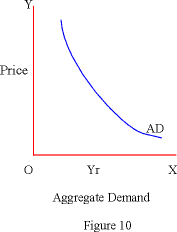4.1 Aggregate Demand
(A) Meaning: Aggregate demand is the
total demand made by all members of the society for all goods and
services. In macroeconomic analysis such aggregate demand is a function of the general level of prices. Here, the price of any individual good or the demand for it from an individual member is not under consideration. In fact it is the demand for all goods and its dependence on the level of all prices that is being analyzed. Such a general level of prices is in the form of a price index which is usually Consumer’s Price Index or CPI. The demand on the other hand represents demand for real national income which can be denoted as Yr.
Aggregate Demand (AD) is then a function of the price level (P)
and the relation between the two can be expressed in the form of a
schedule. By scheduled pairs of prices and AD quantities we mean that
at arbitrarily given prices, expected quantities demanded are related.
On the basis of a demand schedule, as shown below, we can also represent
it graphically.
CURVE

|
AD Schedule
|
|
| Price level | AD quantities or Yr |
|
6
|
10
|
|
5
|
12
|
|
4
|
18
|
|
3
|
30
|
|
2
|
44
|
|
1
|
60
|
In the AD Schedule we notice an inverse relationship between
level of prices and the quantities or real income. As the price level
falls (through 6 to 1) Aggregate Demand goes on increasing (from 10
through 60). In the figure, the same information has been presented
graphically (in the form of the AD curve). In the figure price has been
measured along the vertical and AD quantity along the horizontal axis.
The inverse relation between the two is apparent since the AD curve slopes downwards.
(B) Inverse Relationship: In case of the
individual demand curve the price - quantity relation is inverse and
hence the demand curve slopes downwards. This is because of both substitution effect which is negative and income effect
which is positive. In such cases we concentrate only on the changes in
the price of a single commodity, assuming prices of all the substitute
goods to be constant. Therefore the good (say X) for which price rises,
becomes relatively dearer, and part of its demand is shifted to other
substitutes which are relatively cheaper. Therefore the demand for good
X falls. On the other hand, with rise in the price, the consumer’s
real income falls since the purchasing power of his money income
decreases (he will have to shell out more money to buy the same amount
of good X at its higher price). Hence his demand for good X decreases.
Therefore both price and income effects cause demand to fall with a
rise in the price of a good.
 Home
Home
Tidak ada komentar:
Posting Komentar
Terima Kasih